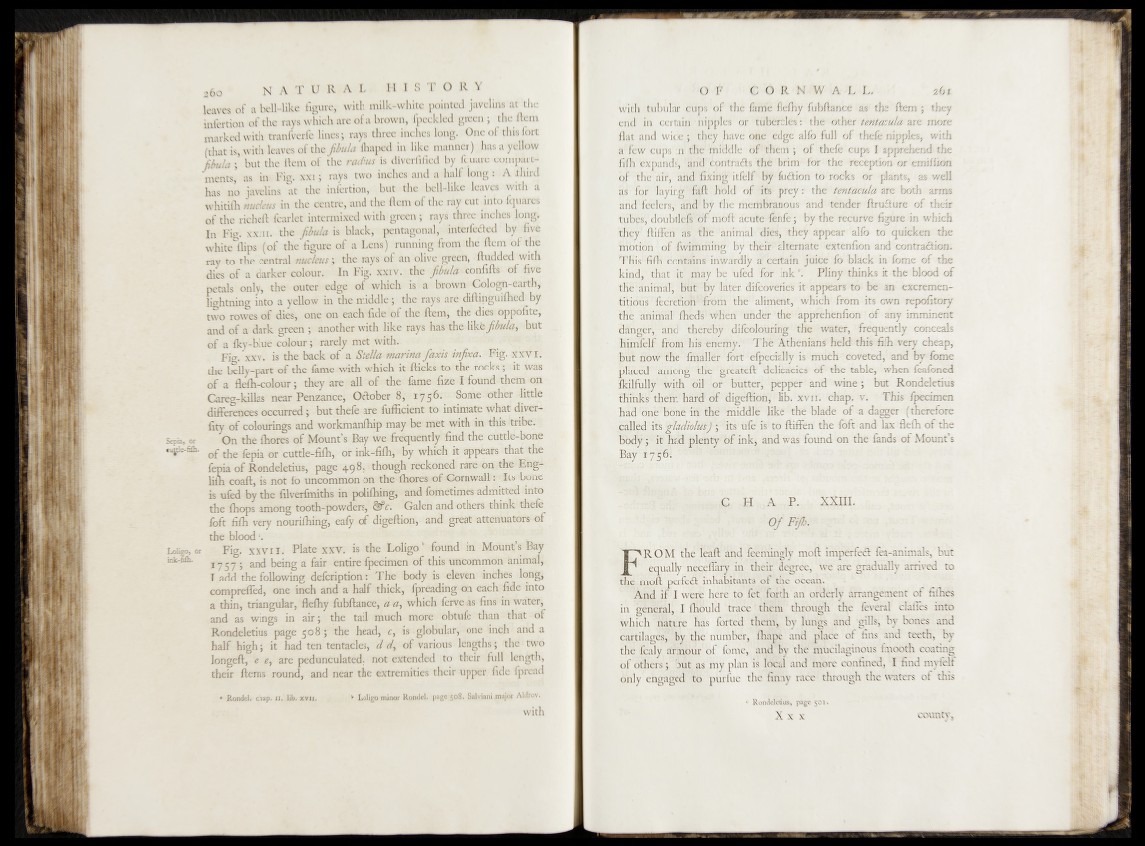
a6o N A T U R A L H I S T O R Y
leaves of a bell-like figure, with milk-white pointed javelins at the
infertion of the rays which are of a brown, fpeckled green; the ftem
marked with tranfverfe lines} rays three inches long. One of this fort
(that is, with leaves of the fibula fliaped in like manner) has a yellow
fibula; but the ftem of the radius is diverfified by fouare compartments,
as in Fig. x x i} rays two inches and a half long : A third
has no javelins at the infertion, but the bell-like leaves with a
whitifh nucleus in the centre, and the ftem of the ray cut into fquares
of the richeft fcarlet intermixed with green} rays three inches long.
In Fig. xxiix. the fibula is black, pentagonal, interfered by five
white flips (of the figure of a Lens) running from the ftem of the
ray to the central nucleus; the rays of an olive green, ftudded with
dies of a darker colour. In Fig. xxiv. the fibula confifts of five
petals only, the outer edge of which is a brown Cologn-earth,
lightning into a yellow in the middle; the rays are diftipguifhed by
two rowes of dies, one on each fide of the ftem, the dies oppofite,
and of a dark green; another with like rays has the like fibula, but
o f a fky-blue colour; rarely met With.
Fig. xxv. is the back o f a Stella marina /axis infixa. Fig. XXVI.
the belly-part o f the fame with which it fticks to the rocks} it was
of a Hefti-colour} they are all o f the fame fize I found them on
Careg-kilks near Penzance, Oftober 8, 1756. Some other little
differences occurred } but thefe are fufficient to intimate what diver-
fity of colourings and workmanfhip may be met with in this tribe.
Sep«, or On the (bores of Mount’s Bay We frequently find the cuttle-bone
“ S*-“ 1* o f the fepia or cutde-fifh, or ink-fifh, by which it appears that the
fepia of Rondcletius, page 498, though reckoned rate on the Eng-
li(h coaft, is not lb uncommon on the fhores o f Cornwall: Its bone
is nfed by the filverfiniths in polifhing, and foffietimes admitted into
the fhops among tooth-powders, & >c. Galen and others think thefe
foft fifh very nourifhing, eafy o f digeftion,- and great attenuators o f
the blood *. j
Indigo, or Fig. XXVII. Plate x xv . is the Loligob found in Mount’s Bay
Ek'®h* * 7 5 7 ; and being a fair entire ipecimen of this uncommon animal,
I add the following defcription: The body is eleven inches long,
compreffed, one inch and a half thick, fpreading on each fide into
a thin, triangular, fleftiy fobftance, a a, which ferve as fins in water,
and as wings in air; the tail much more obtufe than that of
Rondcletius page 508; the head, c, is globular, one inch and a
half high; it had ten tentacles, d of various lengths ; the two
longed, e e, are pedunculated, not extended to their full length,
their ftems round, and near the extremities their upper fide fpread
• Rondel, chap, 11. lib. xvn. * Loligo minor Rondel, page 508. Salvlam major AldWv.
with
O F C O R N W A L L , 261
with tubular cups o f the lame fiefhy fubftanoe as the ftem; they
end in certain nipples or tubercles: the other tentacuhx are more
flat and wide; they have one edge alfo full o f thefe nipples, with
a few cups in the middle of them ; of thefe cups I apprehend the
fifh expands, and contracts the brim for the reception or emiffion
of the air, and fixing itfelf by fu&ion to rocks or plants, as well
as for laying faft hold of its prey: the tenfacula are both arms
and feelers, and by the membranous and tender ftruefure of their
tubes, doubtlefs of moft acute fenfe; by the recurve figure in which
they ftiffen'as the animal'dies, they appear alfo to quicken the
motion of fwimming by their alternate extenfion and contraction.
This fifh contains inwardly a certain juice fo black in feme of the
kind, that it may be ufed for inke. Pliny thinks it the blood o f
the aniinal, Blit by later difcoveries it appears to be an excremen-
titiousv fecretiori from the aliment, which from its own repofitory
the animal fheeff when under the apprehenfion of any imminent
danger, and thereby difcolouring the water, frequently conceals
himfelf from his enemy. The Athenians held this fifh very cheap,
but now the fmaller fort efpecially is much coveted, and by feme
placed among the greateft delicacies of the table, when feafoned
(kilfully with oil or butter, pepper and wine; but Rondcletius
thinks them hard of digeftion, lib. xvn. chap. v. This ipecimen
had one bone iii the middle like the blade o f a dagger (therefore
called its 'filadidlusj ; its ufe is to ftiffen the foft and lax flefh o f the
body; ' it had plenty of ink, and was found on the lands of Mount’s
Bay" 1-7561 U
FI A P. XXIII.
O fF i/b .
FROM the ieaft and feemingly moft imperfedf lea-animals, but
equally neceflary in their degree, we are gradually arrived to
the moft perfect inhabitants o f the ocean.
And if I were here t» let fbrtli an orderly arrangement of fifties
in general, I Ihould trace them through the feveral dalles into
which nature has forted them, by lungs and gills, by bones and
cartilages', by the number, lhape and place of fins and teeth, by
the fcaly armour of Ibnie, and by the mucilaginous ftnooth coating
of others; but as my plan is local and more confined, I find myfelf
only engaged to purfue the finny race through the waters of this
* RondektittS, page 501*
X x x county,